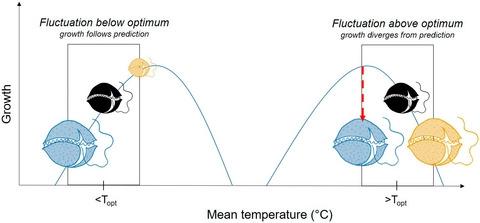当前位置:
X-MOL 学术
›
Glob. Change Biol.
›
论文详情
Our official English website, www.x-mol.net, welcomes your feedback! (Note: you will need to create a separate account there.)
Temperature variability interacts with mean temperature to influence the predictability of microbial phenotypes
Global Change Biology ( IF 11.6 ) Pub Date : 2022-07-06 , DOI: 10.1111/gcb.16330 Fei-Xue Fu 1 , Bernhard Tschitschko 2, 3 , David A Hutchins 1 , Michaela E Larsson 2 , Kirralee G Baker 2, 4 , Allison McInnes 2, 5 , Tim Kahlke 2 , Arjun Verma 2, 6 , Shauna A Murray 2, 6, 7 , Martina A Doblin 2, 7
Global Change Biology ( IF 11.6 ) Pub Date : 2022-07-06 , DOI: 10.1111/gcb.16330 Fei-Xue Fu 1 , Bernhard Tschitschko 2, 3 , David A Hutchins 1 , Michaela E Larsson 2 , Kirralee G Baker 2, 4 , Allison McInnes 2, 5 , Tim Kahlke 2 , Arjun Verma 2, 6 , Shauna A Murray 2, 6, 7 , Martina A Doblin 2, 7
Affiliation

|
Despite their relatively high thermal optima (Topt), tropical taxa may be particularly vulnerable to a rising baseline and increased temperature variation because they live in relatively stable temperatures closer to their Topt. We examined how microbial eukaryotes with differing thermal histories responded to temperature fluctuations of different amplitudes (0 control, ±2, ±4°C) around mean temperatures below or above their Topt. Cosmopolitan dinoflagellates were selected based on their distinct thermal traits and included two species of the same genus (tropical and temperate Coolia spp.), and two strains of the same species maintained at different temperatures for >500 generations (tropical Amphidinium massartii control temperature and high temperature, CT and HT, respectively). There was a universal decline in population growth rate under temperature fluctuations, but strains with narrower thermal niche breadth (temperate Coolia and HT) showed ~10% greater reduction in growth. At suboptimal mean temperatures, cells in the cool phase of the fluctuation stopped dividing, fixed less carbon (C) and had enlarged cell volumes that scaled positively with elemental C, N, and P and C:Chlorophyll-a. However, at a supra-optimal mean temperature, fixed C was directed away from cell division and novel trait combinations developed, leading to greater phenotypic diversity. At the molecular level, heat-shock proteins, and chaperones, in addition to transcripts involving genome rearrangements, were upregulated in CT and HT during the warm phase of the supra-optimal fluctuation (30 ± 4°C), a stress response indicating protection. In contrast, the tropical Coolia species upregulated major energy pathways in the warm phase of its supra-optimal fluctuation (25 ± 4°C), indicating a broadscale shift in metabolism. Our results demonstrate divergent effects between taxa and that temporal variability in environmental conditions interacts with changes in the thermal mean to mediate microbial responses to global change, with implications for biogeochemical cycling.
中文翻译:

温度变化与平均温度相互作用以影响微生物表型的可预测性
尽管它们的热最佳值 ( T opt ) 相对较高,但热带类群可能特别容易受到基线上升和温度变化增加的影响,因为它们生活在接近其T opt的相对稳定的温度中。我们检查了具有不同热历史的微生物真核生物如何响应低于或高于其T opt的平均温度的不同幅度(0 控制,±2,±4°C)的温度波动。世界性甲藻是根据其独特的热特性进行选择的,包括同一属的两个物种(热带和温带Coolia spp.),以及在不同温度下维持超过 500 代的同一物种的两个菌株(热带Amphidinium massartii 分别控制温度和高温,CT 和 HT)。在温度波动下,种群增长率普遍下降,但热生态位宽度较窄的菌株(温带Coolia和 HT)显示出约 10% 的增长下降。在次优平均温度下,处于波动冷阶段的细胞停止分裂,固定的碳 (C) 减少,细胞体积扩大,与元素 C、N 和 P 以及 C: 叶绿素-a成正比. 然而,在超最佳平均温度下,固定 C 被引导远离细胞分裂并开发出新的性状组合,从而导致更大的表型多样性。在分子水平上,除了涉及基因组重排的转录物外,热休克蛋白和伴侣蛋白在超最佳波动(30 ± 4°C)的温暖阶段在 CT 和 HT 中上调,表明保护的应激反应. 相比之下,热带库利亚物种在其超最佳波动(25±4°C)的温暖阶段上调了主要能量途径,表明新陈代谢发生了广泛的变化。我们的研究结果表明,分类群之间存在不同的影响,环境条件的时间变化与热平均值的变化相互作用,从而调节微生物对全球变化的反应,对生物地球化学循环产生影响。
更新日期:2022-07-06
中文翻译:

温度变化与平均温度相互作用以影响微生物表型的可预测性
尽管它们的热最佳值 ( T opt ) 相对较高,但热带类群可能特别容易受到基线上升和温度变化增加的影响,因为它们生活在接近其T opt的相对稳定的温度中。我们检查了具有不同热历史的微生物真核生物如何响应低于或高于其T opt的平均温度的不同幅度(0 控制,±2,±4°C)的温度波动。世界性甲藻是根据其独特的热特性进行选择的,包括同一属的两个物种(热带和温带Coolia spp.),以及在不同温度下维持超过 500 代的同一物种的两个菌株(热带Amphidinium massartii 分别控制温度和高温,CT 和 HT)。在温度波动下,种群增长率普遍下降,但热生态位宽度较窄的菌株(温带Coolia和 HT)显示出约 10% 的增长下降。在次优平均温度下,处于波动冷阶段的细胞停止分裂,固定的碳 (C) 减少,细胞体积扩大,与元素 C、N 和 P 以及 C: 叶绿素-a成正比. 然而,在超最佳平均温度下,固定 C 被引导远离细胞分裂并开发出新的性状组合,从而导致更大的表型多样性。在分子水平上,除了涉及基因组重排的转录物外,热休克蛋白和伴侣蛋白在超最佳波动(30 ± 4°C)的温暖阶段在 CT 和 HT 中上调,表明保护的应激反应. 相比之下,热带库利亚物种在其超最佳波动(25±4°C)的温暖阶段上调了主要能量途径,表明新陈代谢发生了广泛的变化。我们的研究结果表明,分类群之间存在不同的影响,环境条件的时间变化与热平均值的变化相互作用,从而调节微生物对全球变化的反应,对生物地球化学循环产生影响。



























 京公网安备 11010802027423号
京公网安备 11010802027423号